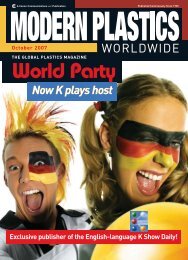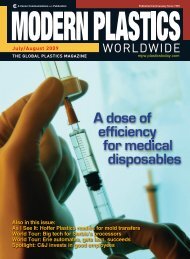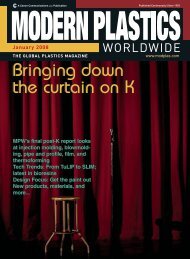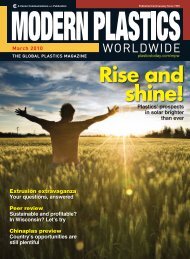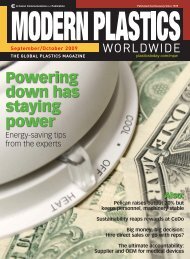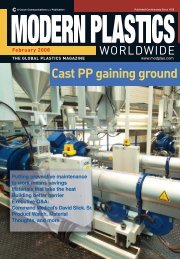amidiq - dae uptlax
amidiq - dae uptlax
amidiq - dae uptlax
Create successful ePaper yourself
Turn your PDF publications into a flip-book with our unique Google optimized e-Paper software.
ln ( W t / W máx )<br />
342<br />
-0.2<br />
-0.4<br />
-0.6<br />
-0.8<br />
-1.0<br />
-1.2<br />
-1.4<br />
N. Martínez-Vázquez et al. / Revista Mexicana de Ingeniería Química Vol. 6, No. 3 (2007) 337-345<br />
-1.6<br />
4.0 4.5 5.0<br />
ln ( t )<br />
5.5 6.0<br />
MC/PAAm 1 MC/PAAm 2 MC/PAAm 3<br />
Fig. 4. Graphic of the Fick Model for the three<br />
hydrogels studied in a basic environment at 40 °C.<br />
3.1. DSC analysis<br />
In Fig. 5, the thermogram of the 80/20<br />
MC/PAAm ratio with 0.5/1.0 initiator/crosslinker<br />
(MC/PAAm 1) after swelling in a neutral<br />
environment at 30 °C is observed. It presents a Tg at<br />
39.06 °C, which is a small Tg due to the fact that<br />
upon being subjected to swelling, its chains are<br />
relaxed and this causes it to diminish.<br />
Heat Flow (W/g)<br />
0.0<br />
-0.1<br />
-0.2<br />
39.39°C<br />
40.48°C(I)<br />
41.16°C<br />
––––––– (a)<br />
––––– · (b)<br />
––– – – (c)<br />
-0.3<br />
0 20 40 60 80 100 120<br />
Exo Up Temperature (°C)<br />
Universal V2.5H TA Instruments<br />
Fig. 5. DSC curves of MC/PAAm hydrogels after the<br />
swelling: a) 80/20 MC/PAAm with 0.5/1.0<br />
initiator/crosslinker (MC/PAAm 1) after the swelling<br />
in a neutral environment at 30 °C, b) 90/10<br />
MC/PAAm with 1.0/0.5 initiator/crosslinker<br />
(MC/PAAm 2) after the swelling in a basic solution<br />
at 30 °C, and 80/20 MC/PAAm with 1.0/1.0<br />
initiator/crosslinker (MC/PAAm 3) after the swelling<br />
in a neutral solution at 30 °C.<br />
According to Ortiz et al. (2006) and Murali<br />
(2006 a,b), the film obtained a Tg of 79 °C before<br />
swelling. In the 90/10 MC/PAAm ratio with 1.0/0.5<br />
initiator/crosslinker (MC/PAAm 2) after swelling in<br />
a basic environment at 30 °C, a Tg at 40.87 °C is<br />
observed for the film (Fig. 5). Fig. 5 presents the<br />
thermogram of the 80/20 MC/PAAm ratio with<br />
1.0/1.0 initiator/crosslinker (MC/PAAm 3) after<br />
swelling in a neutral environment at 30 °C; a Tg of<br />
40.70 °C is observed. The film presented a Tg of 89<br />
°C before swelling (Ortiz et al., 2006).<br />
As observed in Table 5, the vitreous transition<br />
temperature (Tg) in general is very similar on the<br />
MC/PAAm films that presented greater swelling,<br />
which indicates that the conditions to which they<br />
were exposed (solution environment and swelling<br />
temperature, study period) produced the same effect<br />
(chain relaxation) on all the films. It also happens<br />
that the vitreous transition temperature diminishes by<br />
approximately 50%, corroborating that which was<br />
observed in the kinetic study: a relaxation in the<br />
polymeric chains.<br />
3.2. Surface morphologies<br />
In Fig. 6(a), small AAm incrustations are<br />
shown without reacting between 8-10 µm due to the<br />
low concentration of KPS. Having less swelling, this<br />
is corroborated by Fig. 6(c), where, upon increasing<br />
the initiator from 0.5 to 1.0% with a constant crosslinking<br />
concentration, the hydrogel presents a more<br />
homogenous surface without AAm incrustation (Fig.<br />
6c). Furthermore, in Fig. 6(b) it is observed that<br />
incrustations are not present at a neutral pH and a<br />
temperature of 30ºC, due to the effects of the<br />
temperature and pH, and because hydrogels tend to<br />
suffer changes in their morphology as a result of<br />
these variables, they present a homogenous surface<br />
free of monomers and without reacting.<br />
Fig. 7(a) shows a homogenous surface, while<br />
Fig. 7(b) presents a porous structure capable of<br />
retaining and transferring liquids after swelling,<br />
which is to be expected since the porosity of the<br />
material yields a better swelling degree. With regards<br />
to Fig. 7(c), it presents a lesser swelling degree under<br />
the same conditions but with a different<br />
concentration of initiator. Therefore, the hydrogel<br />
shows a more homogenous structure and an increase<br />
in the swelling percentage upon increasing the<br />
concentration of initiator (KPS). This is corroborated<br />
by Fig. 1, since Fig. 7(b) showed 503% swelling,<br />
while Fig. 7(c) decreased its swelling degree to<br />
364%.<br />
Table 5. MC/PAAm hydrogel vitreous transition temperatures.<br />
Sample Test conditions of the swelling test Tg (°C), before swelling Tg (°C), after swelling<br />
MC/PAAm 1 Neutral medium to 30 °C 79 39.39<br />
MC/PAAm 2 Basic Medium to 30 °C 86 40.48<br />
MC/PAAm 3 Neutral Medium to 20 °C 89 39.85<br />
MC/PAAm 3 Neutral Medium to 30 °C 89 41.16<br />
MC/PAAm 3 Neutral Medium to 40 °C 89 41.19



